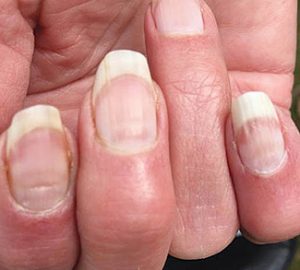 Wondering if you have had the COVID-19 virus? There are reports of COVID tongue, rashes and even fingers and toes – and now there’s yet another possible sign you’ve had the virus: COVID nails.
Wondering if you have had the COVID-19 virus? There are reports of COVID tongue, rashes and even fingers and toes – and now there’s yet another possible sign you’ve had the virus: COVID nails.
Professor Tim Spector, an expert in genetic epidemiology at King’s College London, recently shared a photo of the phenomenon on Twitter, suggesting COVID nails are “increasingly being recognized as the nails recover after infection and the growth recovers, leaving a clear line.”
Also known as Beau’s lines, the horizontal grooves or indentations appear in the nail plate and can be caused by the interruption of growth to the nail due to injury or illness. Spector noted that in COVID patients they can occur without the presence of skin rashes and appear to be harmless. Case reports published in health journals have noted the phenomenon has been recorded in COVID patients elsewhere. One 45-year-old man presented with horizontal grooves on his fingernails and toenails – three and a half months previously, he’d been given a diagnosis of COVID-19 after a positive swab test. His symptoms lasted for 10 days, and he didn’t require admission to hospital.
The indents tend to appear on the fingernails between two and three weeks after an illness – and a bit later in toenails. They are harmless and grow out with time.
NOT A SUREFIRE SIGN
Does having COVID nails mean you had COVID-19?
Not necessarily — many illnesses can cause this, infectious disease expert Amesh A. Adalja, MD, senior scholar at the Johns Hopkins Center for Health Security in Maryland, tells Harvard University’s Health magazine.
“It has been well known that any kind of systemic disease can disrupt nail growth which can be reflected in abnormalities in the appearance of nails,” he says. “This can be seen with any critical illness.” The flu, an infection, and pretty much anything that causes a high fever can also cause these grooves. Even chemo can cause Beau’s lines. “Having it after chemotherapy is a classic case,” Dr. Day says.
It’s important to note Beau’s lines aren’t exclusive to COVID – so it’s not a surefire sign you had the virus. Other causes include trauma to the nail, eczema, severe malnutrition, Raynaud’s disease, hypertension, epilepsy, renal failure, Kawasaki disease and chemotherapy.
LINES WILL GO AWAY
England’s National Health Service, the equivalent to the U.S. CDC lists only three key symptoms of COVID-19: a fever, persistent cough and loss or change to your sense of smell or taste. But other symptoms people with the virus have experienced include rashes, headaches, and digestive issues like nausea and diarrhea. Further symptoms, according to the World Health Organization (WHO), include tiredness, aches and pains, sore throat, conjunctivitis and discoloration of the fingers or toes.
There’s no specific treatment for such lines and researchers note they tend to go back to normal if the underlying condition is resolved. Once that’s happened, it will probably take about six months for the nails – and lines – to grow out and disappear fully. If they don’t grow out, or more appear, it might be worth speaking to a dermatologist or primary physician about whether another underlying condition could be causing it.
Another nail change that appears to be linked to coronavirus is the presence of red half-moon markings on the nails near the cuticles. Researchers aren’t sure why this happens, but they believe it might be something to do with vascular inflammation caused by the virus.
Joshua Zeichner, MD, director of cosmetic and clinical research at the Icahn School of Medicine at Mount Sinai in New York City, said, “The good news is that even without treatment it should correct itself. Once the nail change has happened, it is not permanent, so it is just a waiting game for the nail to grow out.”


